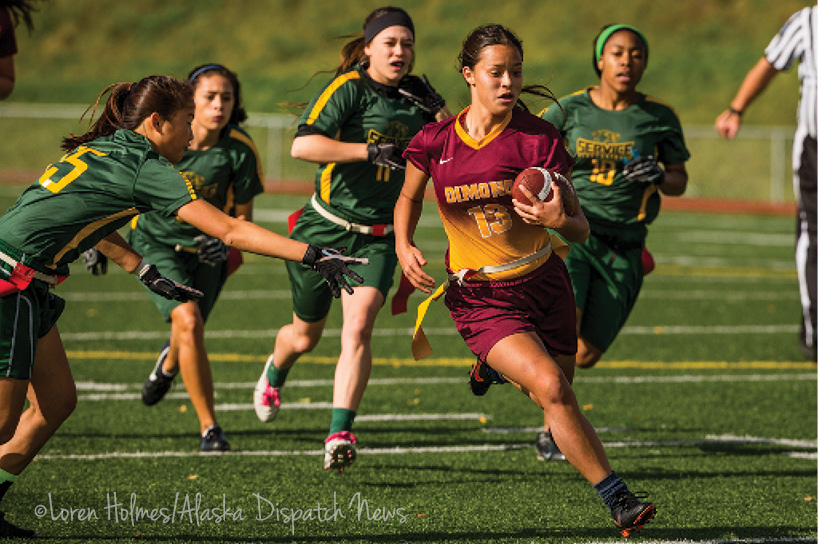Flag Football
A touchdown for girls’ sports in Alaska?
By Jamey Bradbury

If you’re only familiar with flag football as a P.E. alternative to dodgeball or badminton, you might be surprised to hear that this cousin of tackle football is rapidly becoming one of Alaska’s fastest growing girls’ sports.
Popularity contest
The sport was introduced to the Anchorage School District after a 2005 survey of female high school students identified it as the most desired new sport. Bruce McKay, football rules interpreter for the Alaska School Activities Association and a member of the National Federation of State High School Associations’ Football Rules Committee, wasn’t surprised by the survey results.
“Tackle football is one of the most popular games in the world,” he says. While technically girls could be playing tackle football, without girls-only tackle teams, few female athletes try out for boys’ football. Flag football offers girls an acceptable alternative while also eliminating aspects of the game that most concern parents when it comes to safety.
The absence of tackling doesn’t make the sport any less intense, though.
“You can’t be too sensitive; it gets really competitive out there,” says Tiffany Jackson, a running back and outside linebacker for the Dimond Lady Lynx. “Especially with Dimond’s winning streak, everybody wanted to play us. That makes it even more fun because they’re trying really hard, and we have to try just as hard to win.”
In its first year, flag football attracted more than 300 players from eight different schools. Nine years later, at Dimond High School alone, flag football has grown large enough to include nearly 100 girls on five different teams.
Dimond coach Kathleen Navarre attributes flag football’s increasing popularity to the success achieved by her Lady Lynx. Just last year, the Service Cougars had to rally to end the Lady Lynxes’ four-year, 42-game winning streak.
“Anytime you have success, it breeds fun, so more girls want to be apart of it,” Navarre explains. “There’s high expectations from us coaches and the players, but it’s also a sport where they can go out, have fun and be involved in a team and not have the pressure other sports put on athletes who want to go to the college level.”
Reaping the benefits
“The girls compare themselves to the boys,” says Megan Beith, girls’ flag football coach for East High. “Yes, it’s flags, it isn’t tackling, and it’s seven players instead of 11. But the concepts are the same: Can you run through an open space, can you get by people, can you throw the ball, can you run with the ball, can you catch the ball?”
Beith has seen freshman who’ve never played a sport blossom into varsity-level flag football players. “These are the wallflower kids that have never been good at basketball, or volleyball, and we tell them ‘Come try flag football.’ There’s something everyone can do, and just finding the niche for those kids – flag football is starting to be that, and then they get the guts to go try out for basketball or soccer.”
Flag football also provides female athletes an alternative – and a complement – to more traditional girls’ sports.
“It’s a good fall season sport, and it doesn’t really interfere with my softball season,” says 17-year-old Alexis Joubert, a rusher on defense and offensive wide receiver for the East High Thunderbirds. Her main sport is softball, but Joubert takes advantage of flag football in the fall to get in shape. “We do a lot of running, and it’s really good for endurance. I can really work on my speed and increase my sprint.”
In addition to keeping athletes fit in the off-season, says McKay, flag football offers benefits that girls can use on and off the field. “Flag football improves hand-eye coordination. It also increases teamwork; we can complete tasks and get through games more efficiently as a team than as an individual. Then there’s the team captain, which offers a leadership opportunity.”
The next level
Despite its benefits, some parents may question the practicality of their daughters going out for a sport without a future; after all, there are no college-level flag teams and no flag football scholarships. That’s something coaches hope will change as the sport’s popularity continues to spread.
“Eventually, it would be nice if collegiately more were to happen there,” says Navarre. “Another thing I would like to see are other communities getting involved. I know Fairbanks started it last year. I’d like to see the Valley, Wasilla, Palmer get involved because it’s a great alternative for girls to be doing something active during the fall.”
Still, for elite athletes and those who hope sports will earn them a college scholarship, is flag football worth the risk?
“Sometimes seniors don’t want to risk getting hurt if they have scholarship opportunities in other sports,” says Beith – but adds, “Most kids have such a good time with it they stick it out. Flag football correlates so well with those other sports, skill-wise and fundamentally.”
“I know a lot of girls who wish that colleges had flag football teams because they would much rather do that than basketball or something else they could get a scholarship for,” offers Jackson. Lack of scholarship opportunities doesn’t stop players like her from wanting to stay involved beyond high school, though. “My older sister, Kimmy, was a big flag football star at Dimond, and she’s doing leagues now. I would like to keep playing, too, because it’s just so much fun, even if you’re not in an actual league, you still have a great time.”










